"The Freedman" by the American artist John Quincy Adams Ward is one of the Amon Carter Museum's classic pieces. The sculpture is just under 20 inches tall and was created only 160 years ago, but it's classic in that it displays a particular kind of impressive male physique, muscular, lean. The man could be a Greek or Roman athlete, even a god — except for one detail: He is partly shackled with one hand free, the other handcuffed and chained.
The man is twisted in a half-seated posture, and the torqued torso is itself a classic sculptural maneuver, the better to showcase the artist's skills with musculature, the better to make this an in-the-round visual experience. He's not simply seated, facing forward, waiting.
Bu the two handcuffs say everything: "The Freedman" is one of the first bronze portrayals of a Black person in American art, and it deliberately depicts him as only partly free. Adams created it in 1863 in the wake of Lincoln's Emancipation Proclamation. Although Lincoln liberated only those enslaved Americans in the Confederacy, he re-wrote the terms of the Civil War: This was not a war about states' rights, despite the Confederacy's claims. It was about ending slavery.
Eight bronze versions of "The Freedman" exist around the country, indicating its popularity at the time. Adams pushed for it to be made into a grand, heroic-scaled statue. The fact that it never was tells us — appropriately enough — that this 19-inch-tall bronze never achieved its full, hoped-for incarnation.
Which is what inspired the Amon Carter Museum's new show and its revealing title, "Emancipation: The Unfinished Project of Liberation." Co-curated by Margaret Adler of the Amon Carter and Maurita Poole, executive Director of Newcomb Art Museum, Tulane University, "Emancipation" puts Ward's artwork in historical context: Even partly handcuffed, his figure is less subservient, less groveling, than other depictions of African-Americans from the era.
But it also shows us how haunting, how contemporary this figure remains. Seven living artists were asked by the Carter to respond not simply to Ward's artwork but to the history of America that it represents — from issues of covert surveillance and self-protection to incarceration.
But also to the possiblity of taking what was once cast off and making it speak, transforming it.
Here are the seven.
Alfred Conteh

What is it: Alfred Amadou Conteh's art primarily revolves around diasporic Black communities, especially in Atlanta — where he lives and works — and how such groups respond to social issues. Conteh said he likes his work to look as though it’s been rusting because he wants to show the ways that systemic discrimination affects the body. In his sculpture, “Float,” a Black woman carries the weight of the community and of protecting her people. But as she’s rising and floating, she’s also weighed down by discrimination (represented by the chains).
On the other hand, Conteh's painting. “A Charge to Keep," portrays a Black man thinking on how to protect his children — connecting it to the right to bear arms and the right to farm one's own food. A gun and a shovel are in the form of a cross in front of the man and his sons. Conteh said those symbolize things that are used to build a society: “The shovel is a tool to break ground, to build. And the rifle is a tool to protect."
Why is it: Conteh said “Float” centers on tithing and how Black women are the primary contributors to African-American churches. “Ironically, the money that’s tithed is taken to banks, and often those monies are leant out to land development firms,” he said. “And often when those subdivisions are built near or adjacent to Black neighborhoods . . . they price people to move out of their homes.”
What this work says about America's long struggle over emancipation: Both pieces tap into the narrative of being emancipated in name but not in practice, Conteh said. Both touch on protection. Conteh's perspective is that of an artist working in Atlanta, considered a “Black mecca of the South." His work is meant to challenge that image, said Conteh — he hopes to give a no-nonsense look at what it’s actually like for the people who live there. His work reflects on how African-Americans work for liberation, freedom and protection.
A detail viewers can look for: The object behind the woman’s head in Conteh’s “Float” is a church hat, which African-American women typically wore in the 19th century. The hat shows how the church has traditionally been a way for Black women to try to keep their communities whole.
— Galilee Abdullah
Letitia Huckaby

What is it: Fort Worth artist and co-owner of Kinfolk House Letitia Huckaby has pieces from two bodies of work featured in "Emancipation." They are titled “A Tale of Two Greenwoods” and “Bitter Waters Sweet.” The pieces include photos and silhouettes, printed on cotton, cut into oval shapes and framed by embroidery hoops.
Why is it: The heirloom-like quality of the pieces points to the history and family ties explored in the work. “A Tale of Two Greenwoods” was commissioned to commemorate the centennial of the 1921 Tulsa Race Massacre, in which hundreds of people died and were injured when white mobs set ablaze some 35 blocks of Greenwood, the city’s prosperous Black neighborhood. Huckaby’s father was born in Greenwood, Mississippi, and said that several people who helped establish Greenwood in Tulsa, had moved from Mississippi in search of a better life. Photos from each community are hung side-by-side.
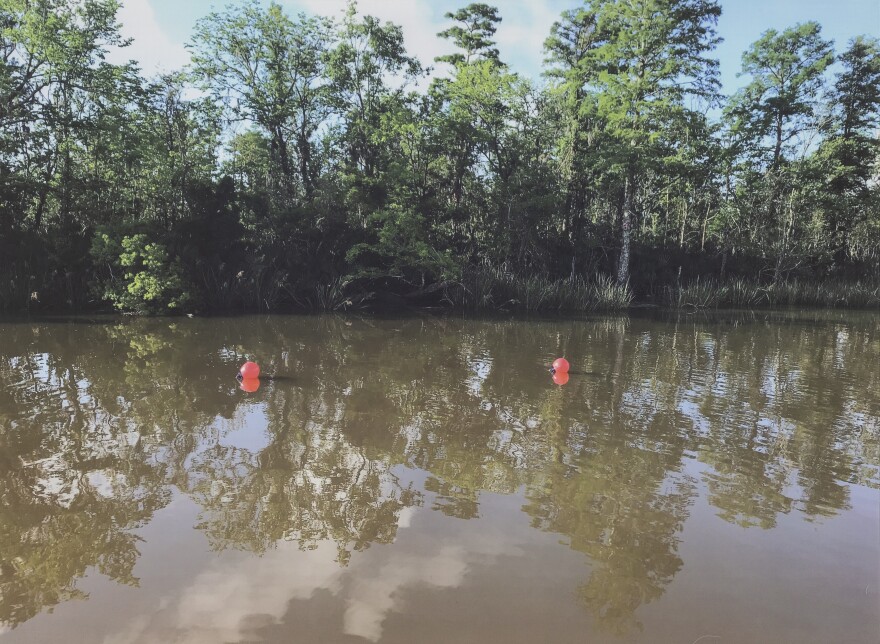
Likewise, “Bitter Waters Sweet” draws on history, but this time in Mobile, Alabama’s Africatown. The area was developed by previously enslaved Africans, many of whom survived the trip through the Middle Passage on a ship named Clotilda — and this was decades after Congress prohibited the “importation” of slaves. Huckaby traveled to Mobile and met with marine archaeologists studying the ship, attended community meetings and spoke with residents, including some who can trace their lineages directly back to family members on the Clotilda.
What this work says about America's long struggle over emancipation: Rooting her pieces in history, Huckaby hopes that the works will encourage viewers to dig deeper into stories they might not otherwise know a lot about. Each of the places Huckaby visited still bears the marks of these stories today, she said.
“The (Tulsa Greenwood) community never got back to the glory it once had. If you go there now, it's literally one block with a highway running through it," Huckaby said. "The community in Alabama is a bit different because they still have descendants there. But, at the same time, it’s pretty much a neighborhood, school and community center. There are no gas stations. There are no hotels and a highway runs through that community as well.”
But emancipation is not a word with a period after it, she said. It is an ongoing process. “If it had been a word with a period, you’d have seen a different result with these communities. They’d be thriving," Huckaby said. "But because emancipation is not a finished thing, it’s an ongoing project, there’s still work that has to be done.”
A detail viewers can look for: Two landscape images featured in “Bitter Waters Sweet” come from the marine archaeologists Huckaby met with. The first is a scan of the river bottom where the boat rests.
The other simply shows the surface of the water, with two red buoys marking where the boat lies.
— Marcheta Fornoff
Jeffrey Meris
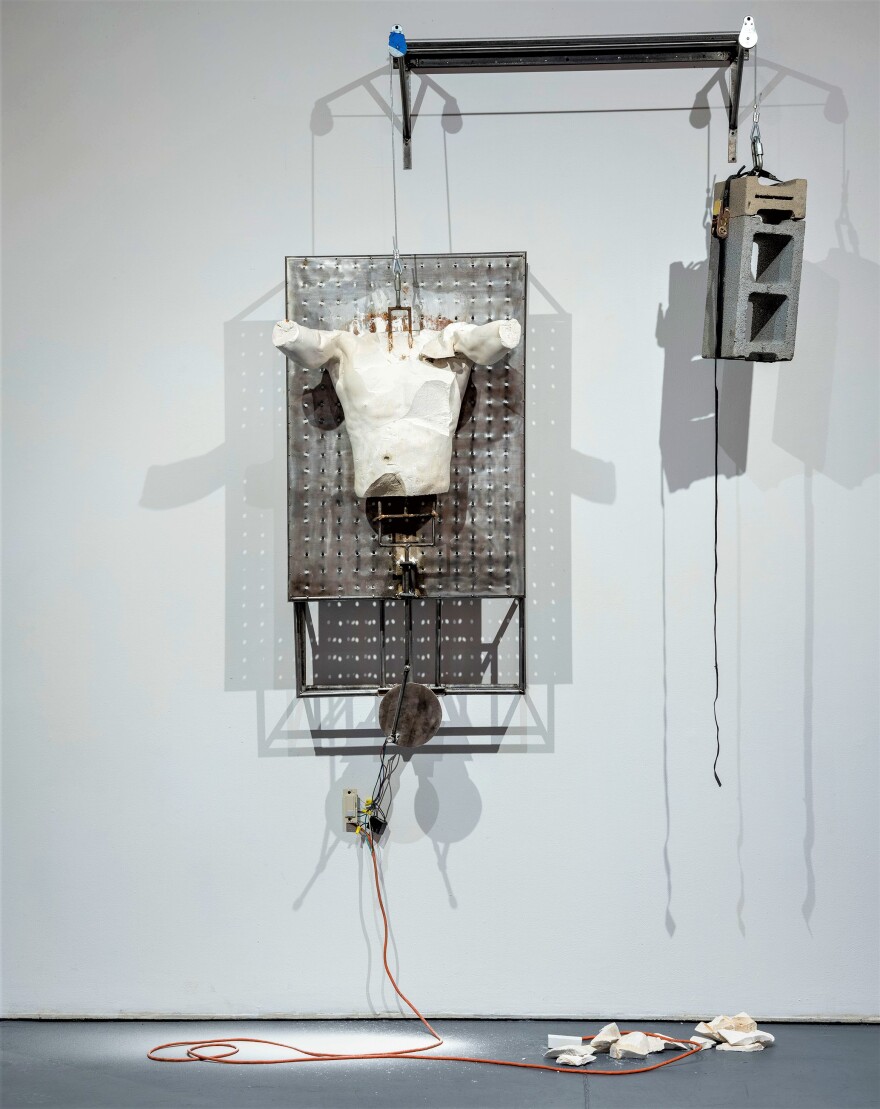
What is it: Multi-disciplinary artist Jeffrey Meris’ pieces in the show are pulled from a body of work called “Now You See Me; Now You Don’t,” including two kinetic sculptures and three drawings.
Why is it: As an immigrant and a Black art student, Meris felt invisible when spending months learning about Western artists and rushing past references to a select few Black artists near the end of a course. But as a Black man, he also felt hyper visible after moving to America. It was this tension that inspired his works.
Meris described one incident when, trying to board a New York train, he swiped his MetroCard unsuccessfully a few times — even though it had a positive balance. So Meris jumped the turnstile.
To this day, Meris said, he is chilled by the experience of cops pulling him off the train and issuing a citation. Knowing the issue was with the machine, and not the amount of money he had on the card, Meris decided to fight the charge. He said he was struck when he was at the court and saw most of the other people with citations were also Black or brown.
What this work says about America's long struggle over emancipation: As a Black man who was born in Haiti and lived in the Bahamas, Meris said he didn’t have to consider the social, cultural and political implications of race head on — until living in America.
“Race is the predominant architectural system in this country,” he said. “It defines everything from employment, housing, access to education and the way streets are named and communities are designed.” His two sculptures are emblematic of the destructive objectification facing Black residents: They feature an isolated head and a headless torso. Both plaster objects are connected to electric motors that push them across an abrasive surface, slowly grinding the pieces into dust.
A detail viewers can look for: Beneath the kinetic sculptures, the fine white dust will accumulate over time, the piles will grow as the plaster figures lose their shapes.
But the action is not entirely destructive, Meris said. “It's almost as if the sculpture is slowly dying. But I think of it as a resurrection or an emancipation rather than a complete death. The sculpture, being white, acts as a stand or metaphor for the white gaze and the violence that this gaze does to others. And so this work is being emancipated from these mythologies.”
—Marcheta Fornoff
Maya Freelon
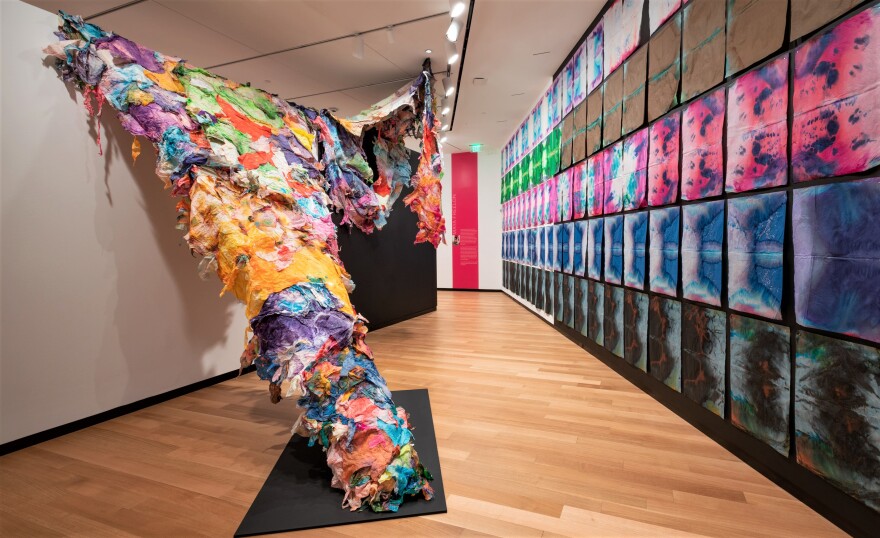
What is it: Maya Freelon has a complete installation of six artworks in the "Emancipation" exhibition, including a gallery wall covered with her characteristic material: brightly-colored, "bleeding" tissue papers. Her most distinctive work here is "Fool Me Once . . . " She calls these kinds of creations "tissue quilts." This one drapes down one wall — or conversely, curves up from the floor. It's a thick, mass of such papers, shaped somewhat like a flattened tornado. Or like a raggedy, rainbow quilt.
The viewer can walk through the installation — and even walk under "Fool Me Once . . . " In an entire exhibition that can be provocative or somber, Freelon eagerly admitted she wanted her particular works to feel like a breathing space for the viewer, a burst of light and color.
Why is it: Freelon said she was inspired to work with water-soaked tissue papers after going through her grandmother's basement ("to be honest, she was a hoarder") and found a sheet with a water stain on it.
"That same weekend," she said, "Hurricane Katrina was bearing down on the Gulf Coast, the levees were breached, Black people fleeing. It was a huge national crisis — and I here was, looking at was left behind by family history and by moving water. It became part of my creative process."
What this work says about emancipation: Having to re-use and re-purpose discarded, unwanted materials like tissue paper, Freelon said, is "quintessentially African-American. We look at the quilts of Gee's Bend now as art, as beautiful soft sculptures. But when they were made, it was simply functional and out of necessity."
Freelon said that she really likes the title of the exhibition — "The Unfinished Project" — implying "that there's so much more to go. Like I mentioned before, Black people are innovators, and of out of necessity, have tried to adapt with what they had. So it's working through ancestral trauma and things that have happened to previous generations that are reverberating still."
A detail viewers can look for: "Fool Me Once . . . " can look as though sizable sheets were glued and layered and strung together. But Freelon said, "When you get closer, you realize there are actually thousands of pieces glued together on top of each other, and many are no bigger than your thumbnail."
— Jerome Weeks
Hugh Hayden

What is it: Hugh Hayden — born and raised in Dallas — responded to John Quincy Adams Ward's sculpture with a 3D printed replica of the original. But it's an "updated freed man," an African-American male figure wearing contemporary, casual clothes (flip-flops, cargo shorts).
Why is it: The white color may seem startling, but Hayden said that for Ward to create his original sculpture in 1863, he made a plaster version first. This would have been shown to patrons or abolitionists to raise money for the bronze castings.
So as incongruous or ironic as the whiteness of the figure might seem, it actually more closely reflects what Ward originally created: "The white colored plastic," Hayden said, "is analogous to the white plaster of 160 years ago."
In his artworks, Hayden typically likes to showcase the "essential nature" of his materials (often bare wood). So rather than paint his figure to look like the oxidized, darkened bronzes, Hayden left the white plastic plain and unsanded.
What this work says about America's long struggle over emancipation: "I wanted to give him agency," Hayden said of his Black male. "These are not like work clothes. He's not like an enslaved person at the mercy of someone else."
Hence, the figure's casual dress and the Adirondack chair replacing the original tree stump. A degree of prosperity and independence have happened in the 160 years since Ward's sculpture: Hayden's figure and chair look like a scene in someone's backyard. Or the family beach house.
"They suggest leisure," Hayden said. "And ownership."
Hayden said he didn't want to "gloss over the stark reality" that Hayden's sculpture represents. "But this artwork is intended to be in dialogue with it." In fact, he pointed out that his Black male retains the original's "halfway" posture as if caught in motion: Is he getting up or sitting down? Is he going forward or back?
A detail viewers can look for: For all the signs of progress that "American Dream" offers, there is, Hayden noted, a small but telling feature that remains from Ward's original.
The roots of that tree stump can be spotted — still here, under the Adirondack chair.
— Jerome Weeks
Sadie Barnette
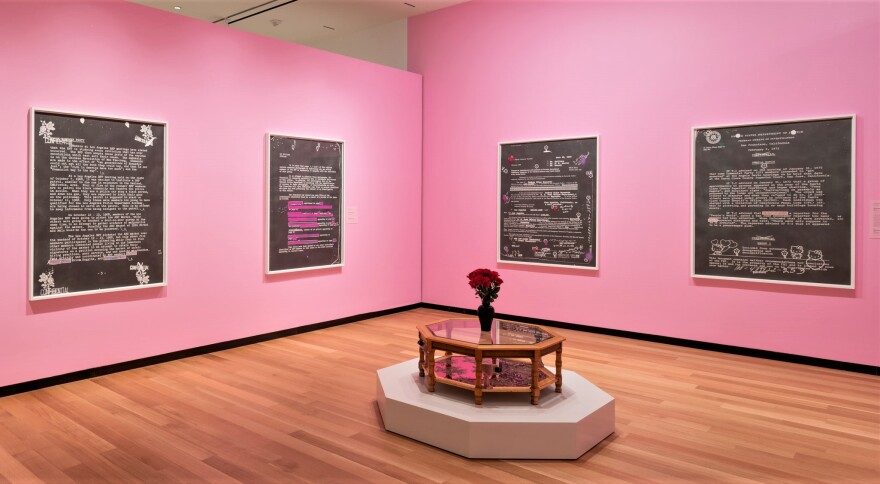
What is it: “The FBI Project” uses parts of the federal bureau's 500-page surveillance file compiled on Sadie Barnette's father, Rodney Barnette. A member of the Black Panther Party, he helped outspoken activist Angela Davis fight for exoneration (guns belonging to her were used in an armed assault on a California courtroom, in which four people died. Davis was held in jail for more than a year before being acquitted of all charges in 1972).
After years of contacting the FBI, Barnette filed a successful Freedom of Information Act request. As she eventually combed through the documents, she decided to use some to make collages and drawings: “I wanted to reclaim them and make them live in my world,” she said.
Why is it: Barnette has embellished the FBI pages with crystals, roses and Hello Kitty faces. They're meant to be symbols of protection and healing from the state-sanctioned violence her family has endured. The spray paint is akin to graffiti tagging, an act of reclamation for her. Barnette explained, “I also figured pink glitter would be a kind of kryptonite to J. Edgar Hoover’s tortured ghost.”
What this work says about America's long struggle over emancipation: Barnette said when she thinks about emancipation, she thinks about abolition. In the Amon Carter exhibition catalog, “Emancipation: The Unfinished Project of Liberation,” Barnette notes, “I think about letting go of how we currently organize our societies and planting something new. I think about letting go of capitalism and imperialism.”
A detail viewers can look for: In one of the pieces from the “FBI Drawings," Barnette has drawn roses. These are meant, she explained, “to honor, mourn and memorialize, to add life, and to suggest evidence of the domestic and rituals of care.”
— Galilee Abdullah
Sable Elyse Smith
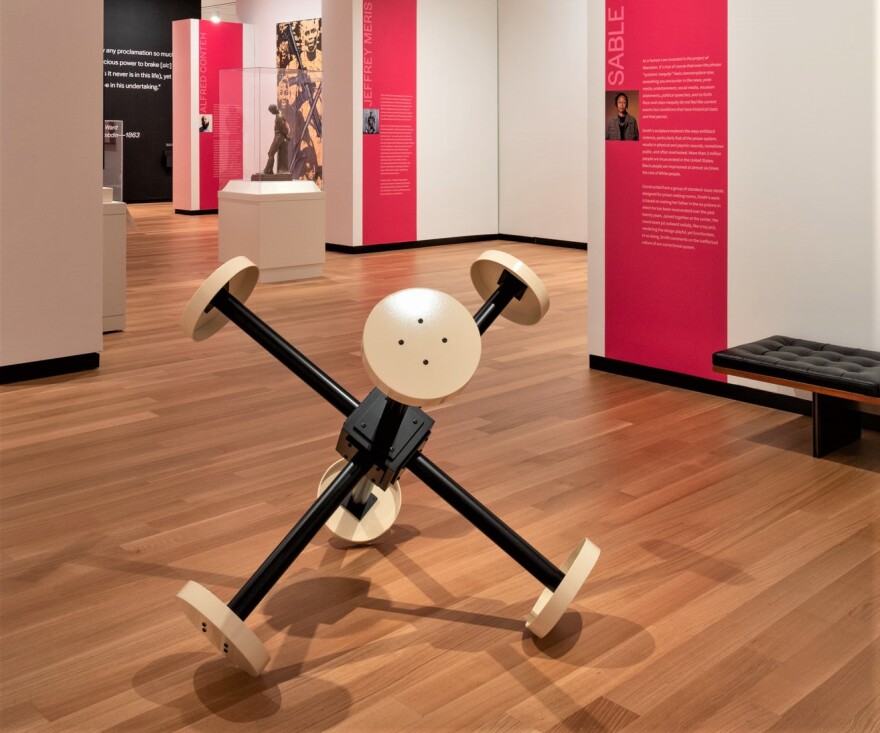
What is it: Known for her writing and mixed-media work, New York-based artist Sable Elyse Smith has large-scale, powder-coated industrial sculptures featured in the exhibition, including "Trappin 1."
Why is it: At first glance, the radiating rods and disks extending out of the sculpture might look like a giant toy jack from the children’s game. But the industrial materials reflect the furniture in prisons across the country — the seating that might be found in a facility’s cafeteria or visitor’s area.
What this work says about America's long struggle over emancipation: Smith’s work shines a direct light on the justice and incarceration systems in the United States by grounding the subject in a physical form. Just as the rods and disks of the sculpture radiate outward, so do the effects of incarceration on families, communities and the country as a whole — though this reality can most acutely be felt in Black and brown communities.
A 2021 report from The Sentencing Project found the incarceration rate for Black Americans is roughly five times that of whites. Additionally, the impact of imprisonment sticks with a person long after they finish their sentence, especially when it comes to applying for jobs, finding housing and political participation. Smith has felt those impacts personally; her father has been incarcerated most of her life.
A detail viewers can look for: Use Smith’s reference of prison furniture to take a moment to reflect on the ways design influences behavior. In a past interview, Smith refered to the way the seats connected to tables in visiting areas have been made so a person’s knees meet the table, making it harder to pass items under it.
— Marcheta Fornoff
"Emancipation: The Unfinished Project of Liberation" at the Amon Carter Museum of American Art through July 9th.
Art&Seek is made possible through the generosity of our members. If you find this reporting valuable, consider making a tax-deductible gift today. Thank you.




